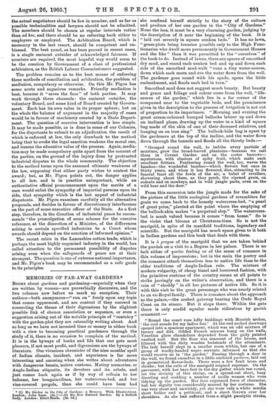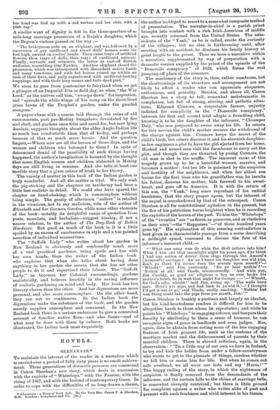BOOKS about gardens and gardening—especially when they are written by
women—are proverbially discursive, and the two volumes now before us mark no exception. Their authors—both anonymous—" run on" freely upon any topic that comes uppermost, and are content if they succeed in connecting the theme of their digressions by the slightest possible link of chance association or sequence, or even a suggestion arising out of the notable principle of " contrky " with the garden-plot they are ostensibly writing about. And so long as we have not invested time or money in either book with a view to becoming practical gardeners through the study of it, there is no occasion to complain of the method. It is in the byways of books and life that one gets most pleasure, if not most profit, and digressions are the byways of literature. Our vivacious chronicler of the nine months' spell of Indian climate, incident, and experience is far more interesting and amusing when she writes about adventures with dangerous beasts, native customs, Mutiny memories, or Anglo-Indian etiquette, its devotees and its rebels, and just comes back again as if by way of refrain to her balsams, her bougainvilleas, her watercress-bed, and her vine-covered pergola, than she could have been had " (1) My Grdett in the City of Garden s: a Memory. With Illnstratio s. London:- John Lane. [68.1-12) My New Zealand Garden. By a Suffolk Lady. London : Elliot Stock. [Sa. 6]
she confined herself strictly to the story of the culture and produce of her one garden in the "City of Gardens."
None the less, it must be a very charming garden, judging by the description of it near the beginning of the book. It is "laid out severely in square sunken beds." It has no lawn, "grass-plots being luxuries possible only to the High Func- tionaries who dwell more permanently in Government Houses and the like" than it was permitted to the " ourselves " of the book to do. Instead of lawns, there are spaces of smoothed dry mud, and round each sunken bed and up and down each side of the smoothed mud-walk "runs a tiny water-course, down which each morn and eve the water flows from the well. The gardener goes round with his spade, opens the little embankment, and floods each bed in turn."
Smoothed mud does not suggest much beauty. But beauty and grace and foliage and colour come from the well, "life- source of the garden," which lies in a far corner of the compound near to the vegetable beds, and the prominence given in the description to the process of irrigation is not out of proportion to its importance. " Moruing and evening the great cream-coloured humped bullocks labour up and down an inclined plane, drawing up the water in a kind of square bag made of the skin of one of their deceased relatives, and hanging on an iron ring." The bullock-hide bag is upset by the gardeners at the top of the incline, and the water flows down through the tunnels and floods all the thirsty beds :—
" Grouped round the well, to imbibe every particle of moisture, grow the broad-leaved plantains—bananas we call them in Covent Garden and on the costar barrows— mysterious, with clusters of spiky fruit, which make such excellent fritters. Feathering round the well, too, waves the bamboo—the wonderful bamboo—which flowers but once in thirty years, and when it has flowered, dies, attracting to its funeral feast all the fowls of the air, a babel of revellers, showering about them, as they perch, the ripened grain, on rodents and on monkeys, and in wild jungle parts, even on the wild boar and the deer."
From this excursion into the jungle made for the sake of the picture of the little zoological gardens of scramblers for grain we come back to the homely watercress-bed, "a pearl of great price," planted at the point where the emptying of the bullock-skin makes "a perpetual slop." The watercress- bed is much valued because it comes "from home." So is the violet that blooms at Christmas-time. So is not the
marigold, in spite of its manifold traditions, legendary and scientific. But the marigold has much space given to it both in Indian gardens and this book that deals with them.
It is a propos of the marigold that we are taken behind the purdah on a visit to a Begum in her palace. There is no lack either of poetic feeling or of the sense of romance in
this volume of impressions; but in the main the poetry and the romance attach themselves less to native life than to the older traditions of Anglo-Indian rule. The mixture of modern vulgarity, of cheap tinsel and borrowed fashion, with the primitive customs of the country seems at all points to strike jarringly on the writer's observation, and there is a vein of " shoddy " in all her pictures of native life. So it is with this visit to the great personage who was nearly related to an ex-Royal family. There is romance about the approach to the palace,—the arched gateway bearing the Onde Royal Crest on its stucco. But it stops there. Within the gate there is only sordid squalor made ridiculous by garish ornament :—
"Round the court rose lofty buildings with Moorish arches, the cool arcade for my ladies fair.' At the end arched doorways opened into a spacious apartment, which was an odd mixture of luxury and dirt. Gilded French mirrors hung on the walls, Venetian glass chandeliers depended from the gaily painted vaulted roof. But the floor was innocent of the broom, and littered with the dirty wooden bedsteads of the attendants. The lady herself slept in a smaller room within, but one of a group of woolly-headed negro servants informed us that she would receive us in the garden.' Passing through a door in the wall, we found ourselves in a little enclosed parterre, laid out in geometrical flower-beds. There were a few fruit trees and shrubs ; but the cults of the marigold reigned supreme. On the pavement, with her bare feet in the dry gutter which ran round, sat the divinity of this shrine, on a spread-out sheet, busy, directing and scolding a number of coolie women who were tidying up the garden. Her face expressed force of character, but her dignity was considerably marred by her costume. She was very stout and unwieldy, yet she wore only a white muslin short bodice and a petticoat, and a sheet thrown over her shoulders. As she had suffered from a slight paralytic stroke,
A similar want of dignity is felt in the three-quarters-of-a- mile-long marriage procession of a Rajah's daughter, which the Begum's visitors passed on the way :—
" The bridegroom rode on an elephant, and was followed by a succession of gay cardboard and tinsel dolls' houses, some six feet high, carried on coolies' heads. Then came trays of artificial flowers, then trays of dolls, then trays of cardboard animals. Finally, servants and retainers, the latter in cast-off British uniforms, resembling Guy Fawkes. Another elephant closed the procession, which was interspersed with discordant native bands and many tom-toms, and with led horses reined up within an inch of their lives, and gaily caparisoned with media3val-looking trappings, and with their long manes and tails dyed pink."
We seem to pass from pantomime to fairyland when we get a glimpse of an Imperial fate or field.day, as when "the War Lord," as the natives call him, "swoops down" for inspection, and "spreads the white wings of his camp on the short-lived grass lawns of the Prophet's garden, under the gnarled mangoes."
A paper-chase with a course laid through the ruins of old cantonments, past pre-Mutiny bungalows devastated by fire and shell, and gardens once trim and cared for, but now lying desolate, suggests thoughts about the older Anglo-Indian life so much less comfortable than that of to-day, and perhaps because of that so much more heroic. And the question lingers,—Where now are all the heroes of those days, and the women and children who belonged to them ? In spite of determined denial of the possibility of such things having happened, the author's imagination is haunted by the thought that some English women and children abducted in Mutiny days are still living in zenanas. And she tells at least one terrible story that a gives colour of truth to her theory.
• The variety of matter in this book of the Indian garden is truly wonderful. And all the matter is vital. We only wish the pig-sticking and the chapters on taxidermy had been a little less realistic in detail. We could also have spared the chapter on hand-shaking, which is commonplace without being simple. The gossip of afternoon "callers" is retailed
in the vivacious, not to say malicious, vein of the author of Wiizabeth and her German Garden, while some other elements qf the book—notably its delightful range of quotation from poets, moralists, and herbalists—suggest kinship, if not a nearer relation, to the author of The Day-Book of Bet hia Hardacre. But good as much of the book is, it is a little
spoiled by an excess of carelessness in style and a too pointed assertion of individual mannerisms.
The "Suffolk Lady" who writes about her garden in
New Zealand is obviously and confessedly much more of a real practical gardener, using spade and hoe with her own hands, than the writer of the Indian book
who explains that when she talks about having done anything in her garden she means that she has set other people to do it and supervised their labour. The "Suffolk
Lady," as becomes her Colonial surroundings, gardens realistically, and believes heartily in the saving influence of realistic gardening on mind and body. Her book has less literary charm than the other. And her digressions are more personal, and also more commonplace. On the other hand, they are not so continuous. In the Indian book the digressions make the substance of the book, and the garden merely supplies atmosphere and ornament. In the New Zealand book there is a serious endeavour to give a connected account of familiar native flora—and also fauna—and of what may be done with them by culture. Both books are illustrated, the Indian book most exquisitely.



































 Previous page
Previous page